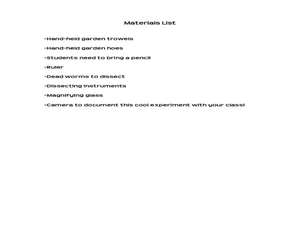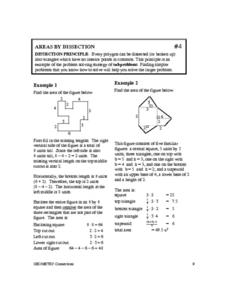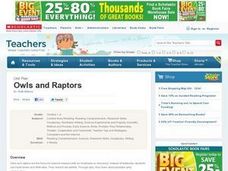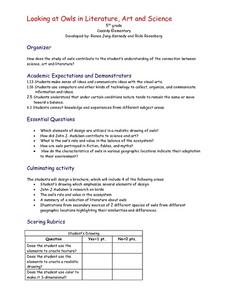Curated OER
A Science Trail: Worms
Third graders explore worms in multiple ways. In this lesson on worms, 3rd graders search for worms in their natural environment, record data on worms, and dissect worms.
Curated OER
Owls are a Hoot!
Students construct a food web based on the animals found inside owl pellets. For this owls lesson plan, students research and describe the characteristics of owls as well.
Curated OER
Taking Apart Owl Pellets
Students dissect an owl pellet. In this rodent and bone structure lesson, students work in groups to take apart an owl pellet. Students separate all the tiny bones from the fur and use the bones to reconstruct the rodent on a tag board....
Curated OER
Fetal Pig Dissection
In this dissection worksheet, students use a preserved fetal pig to learn more about anatomical terms and body systems. Detailed diagrams and instructions are provided to guide the students through the dissection. Students complete 81...
Curated OER
Dissecting Owl Pellets
Students explore owl pellets. In this animal science lesson, students use owl pellet dissection kits to dissect one owl pellet. Students use a magnifying glass to identify the foods that the owl ate.
Curated OER
Dissection Webquest
In this dissection webquest, students research information on the internet about dissections. Students compare the 4 websites to note differences in the definitions, explanations, and graphics presented of the term dissection. Students...
Curated OER
Areas by Dissection
In this areas by dissection worksheet, learners find the area of given composite figures. This three-page worksheet contains examples, explanations, and 16 problems. Answers are provided on page three.
Curated OER
Dissecting Crickets
Learners dissect a cricket and note the three body regions, wings, and legs. They observe the yellow malphigian tubes and remove them. They dissect the esophagus and analyze the heart for respiratory rates and heart beat rates.
Alabama Learning Exchange
Nocturnal Animals Lesson #4: Owls
Students investigate the owl food chain. They discuss owl facts, explore various websites, dissect an owl pellet, create a picture of the owl food chain, read the book, "Owl Babies," and write an owl poem.
Curated OER
Owl Pellets
Students examine and discuss what owls eat and how their digestive system works. They dissect owl pellets, identify the bones found, and analyze and record the results.
Curated OER
Introduction to Organs/Organ Systems via Frog Dissection
Young scholars are to create, in groups of four, the insides of a frog. This is in preparation for the frog dissection that will follow this introductory instructional activity. Students can begin predicting what the inside of the frog...
Curated OER
Anatomy of the Heart
Tenth graders examine the different parts of the heart. In this biology lesson, 10th graders perform dissection of the fetal pig. They explain how the heart maintains homeostasis.
Curated OER
Paleoecology Using "Fossilized" Owl Pellets
Learners study the differences in anatomy to help identify different species and use a dichotomous key to identify what the owls were eating. In this investigative instructional activity students dissect owl pellets to identify the...
Curated OER
Digital Dissections
Young scholars dissect organisms and take photographs to create a PowerPoint dissection library. In this anatomy lesson, students dissect organisms that interest them and photograph the process while identifying structures. They create a...
Curated OER
Classification of an Echinoderm
High schoolers study starfish through dissection. In this biology lesson plan, students explore the lives of starfish as they view a slide show, observe parts of echinoderms, and compare the classification of the starfish with other...
Curated OER
Owl Pellets
Students discover the contents of an owl pellet. In this science lesson plan, students explore the eating habits of owls and compare the contents of an owl pellet to the human skeletal system.
Curated OER
Learning the Dissecting Planes
Middle schoolers explore dissecting planes. For this biology lesson plan, students learn the basic vocabulary used in dissection, learn how to orient themselves on a three dimensional figure, and develop the manual dexterity necessary to...
Curated OER
Barn Owl Pellet Lab
In this lab learning exercise, learners dissect a barn owl pellet then identify the different small animals found in the owl pellet. Using class data they calculate percentage present as well as complete 8 post lab questions.
Curated OER
Owls and Raptors
Students investigate the predator-prey relationship of owls and raptors. They examine a variety of resources about owls and raptors, develop a list of vocabulary words, dissect owl pellets and identify what owls eat, and play a...
Curated OER
Fish Anatomy
Students identify and interpret the internal anatomy of the fish. They also identify and define vocabulary for anatomical parts and anatomical functions and forms. Finally, students identify and interpret the differences in fish...
Curated OER
Discovering Owls
Students are introduced to different types of owls and owl pellets. They list several adaptations that benefit the owls. Students identify the various species of owl that live in Wisconsin. Students discuss owl pellets and identify the...
Curated OER
Identifying Trophic Levels Through the Dissection of Owl Pellets
Students discover a part of the natural food chain through the dissection of owl pellets. They compare, identify, and record rodent skeletal parts they find in the pellet to skeletal diagrams and try to reconstruct a skeleton from the...
Curated OER
Flower Dissection
Pupils investigate th anatomy of a flower. They investigate the structures and processes by which flowering plants generate pollen, ovules, seeds, and fruit through dissection,
Curated OER
Looking at Owls in Literature, Art, and Science
Fifth graders investigate the characteristics of owls through various science and art activities. They analyze drawings by J.J. Audubon and complete a Venn diagram comparing the similarities and differences of different kinds of owls,...

























